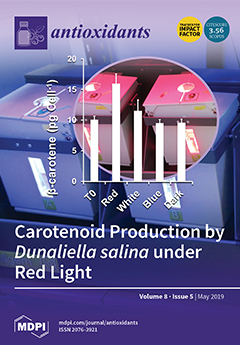Dunaliella salina is a rich source of
9-cis β-carotene, which has been identified as an important biomolecule in the treatment of retinal dystrophies and other diseases. We previously showed that chlorophyll absorption of red light photons in
D. salina is coupled with oxygen reduction and phytoene desaturation, and that it increases the pool size of β-carotene. Here, we show for the first time that growth under red light also controls the conversion of extant
all-trans β-carotene to
9-cis β-carotene by β-carotene isomerases. Cells illuminated with red light from a light emitting diode (LED) during cultivation contained a higher
9-cis β-carotene content compared to cells illuminated with white or blue LED light. The
9-cis/
all-trans β-carotene ratio in red light treated cultures reached >2.5 within 48 h, and was independent of light intensity. Illumination using red light filters that eliminated blue wavelength light also increased the
9-cis/
all-trans β-carotene ratio. With norflurazon, a phytoene desaturase inhibitor which blocked downstream biosynthesis of β-carotene, extant
all-trans β-carotene was converted to
9-cis β-carotene during growth with red light and the
9-cis/
all-trans β-carotene ratio was ~2. With blue light under the same conditions,
9-cis β-carotene was likely destroyed at a greater rate than
all-trans β-carotene (
9-cis/
all-trans ratio 0.5). Red light perception by the red light photoreceptor, phytochrome, may increase the pool size of anti-oxidant, specifically
9-cis β-carotene, both by upregulating phytoene synthase to increase the rate of biosynthesis of β-carotene and to reduce the rate of formation of reactive oxygen species (ROS), and by upregulating β-carotene isomerases to convert extant
all-trans β-carotene to
9-cis β-carotene.
Full article






